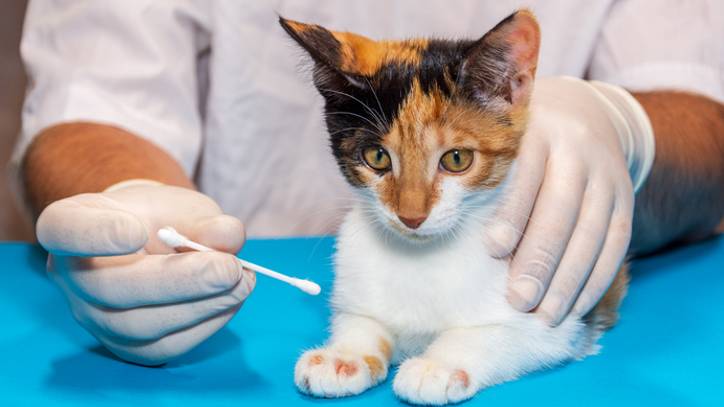Ringworm in cats: Vet's guide to symptoms and treatment
Are you worried about ringworm in cats? Keep your family and pets safe by knowing what to look for

Ringworm in cats can cause skin lesions on other pets as well as humans. This article will explain all about ringworm in cats, from symptoms and how it's spread, to treatment and prevention.
It's important to remember that cats get many other problems with their skin, so if you notice a problem with your cat's skin it might not necessarily be ringworm. It could be that you have a cat with allergies, there’s a flea infestation or it’s mange mites that are causing the problem.
So, how do you know if your cat’s skin problems are caused by ringworm? Let’s find out.
What is ringworm in cats?
You’d be forgiven for thinking, due to its name, that ringworm is a type of worm. However, ringworm isn’t actually caused by a worm at all. So, what causes cat ringworm? Despite its misleading name, ringworm is caused by a fungal infection.
The family of fungi that causes ringworm are known as dermatophytes. Different dermatophytes can infect different species of animal, however, there is a lot of cross-over, meaning that humans and dogs are also susceptible to ringworm from cats.
How do cats get ringworm?
Dermatophytes spread very easily between infected animals or people, but ringworm can also be caught from contaminated objects or surfaces. The ringworm fungus on any untreated surface can linger for up to eighteen months, meaning that cross infection from contaminated brushes, bedding, or other items is common if proper hygiene isn’t used.
This means that even indoor cats are at risk, especially if the pet parent has contact with other animals or contaminated pet equipment. Another issue with cats getting ringworm is that they can carry the fungus without showing any signs. These asymptomatic carriers can spread the fungus to other cats, dogs, or even people, without it being obvious that they are the source.
Get the best advice, tips and top tech for your beloved Pets
Signs of ringworm in cats
The symptoms of ringworm in cats aren't as straightforward as you might think. For instance, ringworm is so-called because the bald, crusty skin lesions are often round or ring-shaped. However, this isn't always the case, and skin lesions can be irregularly shaped and variable in size.
Some cats with ringworm just have a slightly scurfy coat or brittle, flaky nails, and some will show no signs at all. This means it’s important to get your cat checked by a vet if any skin or coat symptoms, no matter how mild. If you, a member of your family, or another of your pets is diagnosed with ringworm, you should get your cat checked by the vet even if they seem fine.

How long are cats contagious with ringworm?
If your cat’s ringworm is left untreated, they may remain infected and contagious for around six months. However, even with the right treatment given at the correct dose, your cat will still be contagious for at least three weeks. Don't forget though, they could also be contaminating their environment during this time.
You might wonder, if that’s the case, how long does a cat with ringworm need to be quarantined? Well, you should consider your cat and their environment contagious and continue treatment until they have tested negative for dermatophyte culture twice. Your veterinarian will be able to advise you of when it’s safe to stop treatment.
Treating ringworm in cats
Sadly, there are no effective home remedies for ringworm. Topical and oral anti-fungal treatments can be used and will need to be prescribed by your vet. It’s important to follow the vet’s instructions strictly, and not stop the medication early or miss any treatments.
You might be tempted to wash your cat in the bath, to help to clear up the ringworm faster. But should you bathe a cat with ringworm? The answer is no, unless your vet has prescribed a medicated anti-fungal shampoo, it’s best not to bathe your cat because normal pet shampoo won’t be effective, and you’ll cause more environmental contamination.
Managing ringworm at home
If your cat or another pet has been diagnosed with ringworm, you should avoid direct contact with them and wear gloves when you are treating them. If possible, you should keep them confined to an area of the house where they have no direct contact with other pets or people.
That way, you can also reduce the spread and keep environmental contamination to a minimum. Surfaces and objects that they are in contact with should be disinfected daily, as should any combs, brushes, food bowls, and other objects.

Can humans get ringworm from cats?
Humans and dogs can get ringworm from cats through direct contact or contact with contaminated surfaces.
Can ringworm live in cat litter?
Dermatophytes, the fungus causing ringworm, can live on surfaces and objects including combs, bowls, and cat litter for up to 18 months. Therefore, if your cat is diagnosed with ringworm it’s important to deal with the fungal spores in the environment too.

Dr Hannah Godfrey is a small animal vet with a love of dentistry and soft tissue surgery. She lives in Wales with her partner, son, and their two cats.
Preventing ringworm in cats
While disinfecting pet brushes and using strict hygiene measures after handling other animals will help to reduce the chances of ringworm, sadly it can’t be prevented. However, if you know what to look for you can spot the signs early.
If you brush your cat regularly, you’ll know what’s normal for them and quickly notice any changes that could suggest a problem. If you’re concerned about whether your cat might have ringworm, your veterinarian can send some coat brushings to the laboratory to check for dermatophytes.
Summary
Ringworm in cats can be a real problem, and it can cause skin lesions on your family and other pets. If you notice any changes in your cat's skin or fur, you should take them to the vet. If the veterinarian diagnoses ringworm, follow the treatment protocol closely to make sure that the infection clears up quickly and doesn’t come back.
Find out the difference between ringworm and hot spots on cats here.
Dr Hannah Godfrey is a small animal vet who graduated from the Royal Veterinary College in 2011 and began work straight away at a busy mixed practice. Initially, she treated all species, but focussed on small animals from 2014. She has a passion for soft tissue surgery, ultrasound, and canine and feline dentistry, having completed additional training in these areas.
